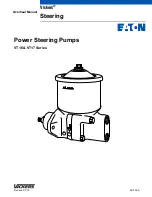
Pay special attention to hedges which are positioned along wire fencing. If the cutting blades contact the
fence, damage may occur. If the blade meets a stone, wire or other foreign object, stop immediately and check
for any damage to the blades immediately.
Do not attempt to remove any twigs or branches jammed in the blades, without first turning the engine off.
Always check for any damage before each use and replace damaged blades immediately, with an approved
replacement part.
Always fit the supplied blade guard when the Hedgecutter is not in use.
BRUSHCUTTER
WARNING
Always wear safety goggles or glasses to protect your eyes. Never lean over the rotating head. Stones or
other debris could be thrown towards your face and cause serious personal injury.
Always keep the guard in place.
Operate with the power unit on your right side, using the Shoulder Strap. Always keep a firm grip with both
hands during operation. The machine should be held at a comfortable position, with the trigger handle at hip
height. Adjust the shoulder strap to suit.
Maintain a firm footing in case the machine hits a solid object & kicks back. Do not use the Brushcutter near
fencing, posts, buildings or other immoveable objects. If a hard object is struck, immediately stop the machine
and inspect for damage.
Use the front left side of the cutting rotation. Guide the blade from left to right, with the blade tilted slightly
towards the left.
Be sure that the blade and holder are positioned and secured correctly. If assembled incorrectly, excessive
vibration made be felt and the machine must be stopped immediately, and the correct assembly instructions
followed.
Do not attempt to cut foliage which is too long. We recommended you cut long foliage in stages. The blade
may become seized by foliage if the engine speed is too low or you attempt to cut too deep into the growth.
Adjust the engine speed and cut in stages to avoid stoppages.
WARNING
DO NOT contact the metal blade with utility wires, metal stakes, rubber, masonry, rocks, fences, and trees.
DANGER
Rocks & metal can dull or damage a blade. Wires can wrap around the blade head or be thrown in the air.
DO NOT cut with a dull, cracked or damaged metal blade.
Before cutting, inspect for obstructions. If an obstruction cannot be removed, mark its location clearly so
you can avoid it during operation.
SCYTHING WEEDS
This is cutting by swinging the blade in a level arc. It can quickly clear areas of field grass and weeds. Scything
should not be used to cut large, tough weeds or woody growths.
Scything can be done in both directions, or just in one way which results in the debris being thrown away from
you. This is done by using the side of the blade that it is rotating away from you. Tilt the blade downwards
slightly, on this same side. You will be hit by some debris if you scythe in both directions
















































